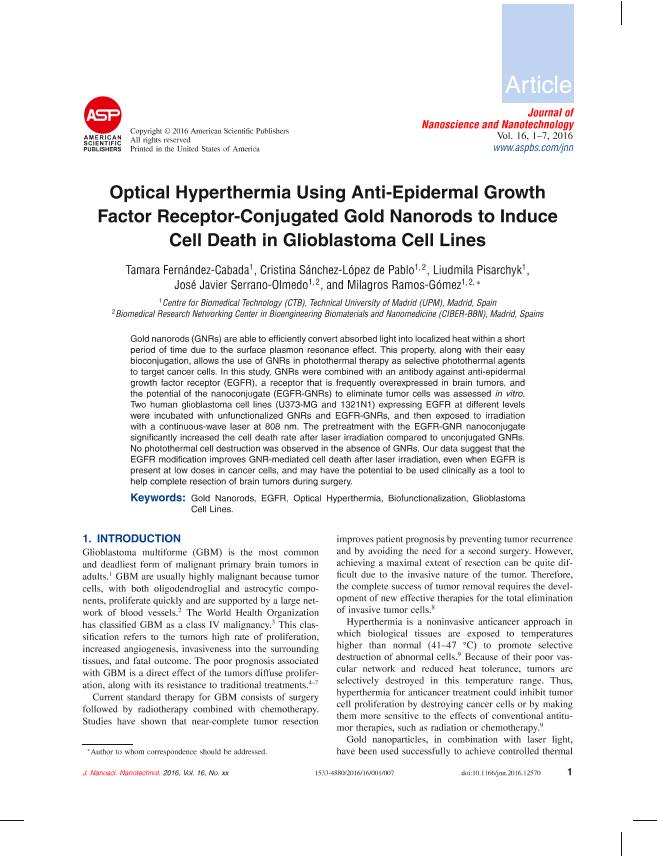Mostrar el registro sencillo del ítem
dc.contributor.author
Fernández Cabada, Tamara

dc.contributor.author
Pablo, Cristina Sánchez López de
dc.contributor.author
Pisarchyk, Liudmila
dc.contributor.author
Serrano Olmedo, José Javier
dc.contributor.author
Ramos Gómez, Milagros
dc.date.available
2018-05-30T13:01:34Z
dc.date.issued
2016-07
dc.identifier.citation
Fernández Cabada, Tamara; Pablo, Cristina Sánchez López de; Pisarchyk, Liudmila; Serrano Olmedo, José Javier; Ramos Gómez, Milagros; Optical Hyperthermia Using Anti-Epidermal Growth Factor Receptor-Conjugated Gold Nanorods to Induce Cell Death in Glioblastoma Cell Lines; American Scientific Publishers; Journal of Nanoscience and Nanotechnology; 16; 7; 7-2016; 7689-7695
dc.identifier.issn
1533-4880
dc.identifier.uri
http://hdl.handle.net/11336/46568
dc.description.abstract
Gold nanorods (GNRs) are able to efficiently convert absorbed light into localized heat within a short period of time due to the surface plasmon resonance effect. This property, along with their easy bioconjugation, allows the use of GNRs in photothermal therapy as selective photothermal agents to target cancer cells. In this study, GNRs were combined with an antibody against anti-epidermal growth factor receptor (EGFR), a receptor that is frequently overexpressed in brain tumors, and the potential of the nanoconjugate (EGFR-GNRs) to eliminate tumor cells was assessed in vitro. Two human glioblastoma cell lines (U373-MG and 1321N1) expressing EGFR at different levels were incubated with unfunctionalized GNRs and EGFR-GNRs, and then exposed to irradiation with a continuous-wave laser at 808 nm. The pretreatment with the EGFR-GNR nanoconjugate significantly increased the cell death rate after laser irradiation compared to unconjugated GNRs. No photothermal cell destruction was observed in the absence of GNRs. Our data suggest that the EGFR modification improves GNR-mediated cell death after laser irradiation, even when EGFR is present at low doses in cancer cells, and may have the potential to be used clinically as a tool to help complete resection of brain tumors during surgery.
dc.format
application/pdf
dc.language.iso
eng
dc.publisher
American Scientific Publishers

dc.rights
info:eu-repo/semantics/openAccess
dc.rights.uri
https://creativecommons.org/licenses/by-nc-sa/2.5/ar/
dc.subject
Gold Nanorods
dc.subject
Egfr
dc.subject
Optical Hyperthermia
dc.subject
Biofunctionalization
dc.subject.classification
Nano-materiales

dc.subject.classification
Nanotecnología

dc.subject.classification
INGENIERÍAS Y TECNOLOGÍAS

dc.title
Optical Hyperthermia Using Anti-Epidermal Growth Factor Receptor-Conjugated Gold Nanorods to Induce Cell Death in Glioblastoma Cell Lines
dc.type
info:eu-repo/semantics/article
dc.type
info:ar-repo/semantics/artículo
dc.type
info:eu-repo/semantics/publishedVersion
dc.date.updated
2018-05-29T18:37:08Z
dc.journal.volume
16
dc.journal.number
7
dc.journal.pagination
7689-7695
dc.journal.pais
Estados Unidos

dc.description.fil
Fil: Fernández Cabada, Tamara. Universidad Politécnica de Madrid; España. Consejo Nacional de Investigaciones Científicas y Técnicas; Argentina
dc.description.fil
Fil: Pablo, Cristina Sánchez López de. Universidad Politécnica de Madrid; España. Centro de Investigación Biomédica en Red; España
dc.description.fil
Fil: Pisarchyk, Liudmila. Universidad Politécnica de Madrid; España
dc.description.fil
Fil: Serrano Olmedo, José Javier. Universidad Politécnica de Madrid; España. Centro de Investigación Biomédica en Red; España
dc.description.fil
Fil: Ramos Gómez, Milagros. Universidad Politécnica de Madrid; España. Centro de Investigación Biomédica en Red; España
dc.journal.title
Journal of Nanoscience and Nanotechnology

dc.relation.alternativeid
info:eu-repo/semantics/altIdentifier/doi/https://dx.doi.org/10.1166/jnn.2016.12570
dc.relation.alternativeid
info:eu-repo/semantics/altIdentifier/url/http://www.ingentaconnect.com/content/asp/jnn/2016/00000016/00000007/art00154
Archivos asociados
